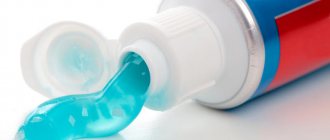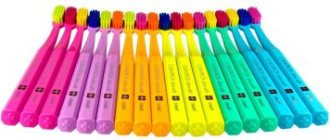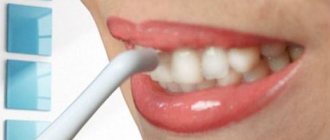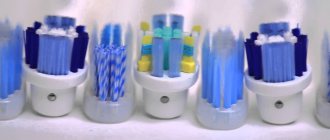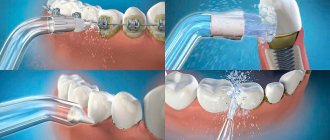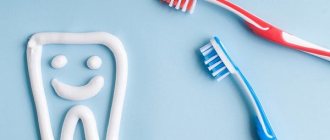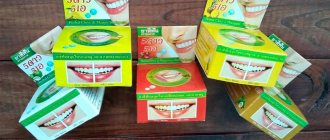- Sound and ultrasound: what are we talking about?
- Ultrasonic brush
- How to brush your teeth with an ultrasonic brush
- Ultrasonic brush: pros and cons
- How to choose an ultrasonic toothbrush
- Sonic toothbrush
- How to brush your teeth with a sonic brush
- Sonic Toothbrush: Pros and Cons
- How to choose a sonic toothbrush
- What is the result: a sonic or an ultrasonic brush?
Sonic and ultrasonic brushes can be confused due to their similar names. But they have different operating principles. In this article we will look at how they differ, how to choose one brush or another, and what are the pros and cons of these technologies.
Design Features
Inside the ultrasonic brush there is a motor and a piezoceramic plate, which is located under the bristles. The plate oscillates at a frequency of 1.6-1.7 MHz, and the bristles vibrate up to 100 million times per minute. It is this vibration frequency that ensures ultrasound penetration deep into the teeth and gums by 4 mm.
An ultrasonic brush is capable of cleaning even hard-to-reach areas (gaps between teeth, periodontal pockets, gingival grooves). How do ultrasonic brushes differ from sonic ones: the former produce high-frequency oscillatory waves, which provide up to 100 million movements per minute, while sonic ones generate waves in the audio range with a lower frequency (32 thousand per minute, but with greater amplitude).
How electric brushes work
If you compare the efforts made to brush your teeth with a regular brush, which everyone is accustomed to since childhood, and an electric one, then the advantages will undoubtedly be with the latter. After all, the 2-3-5 minutes that you need to spend carefully cleaning all surfaces, corners, spaces and grooves in your teeth, while straining your fingers, sometimes turning your hand in the right direction, can be successfully replaced with a simplified process, spending much more on it less time and effort. And an electric toothbrush will save this time.
The secret is simple: a special motor is built into the body of such a brush, and with its help the bristles are set to a certain speed. In addition, the bristles have the ability to change the direction of their rotation: from circular rotation to up and down movement. It is this ability of the bristles that allows you to more thoroughly clean accumulated dirt, and simply complete cleaning several times faster.
Operating principle of an ultrasonic brush
The bristles remove plaque due to oscillatory movements; ultrasonic waves help to destroy the basis of microbial deposits. Vertical movements clean the surface of the teeth from plaque.
The ultrasonic brush can effectively remove soft deposits, partially mineralized and weak pigment. Tartar should only be removed during a professional cleaning session.
When cleaning your teeth with an ultrasonic brush, you feel a slight warmth: under the influence of ultrasound, the tissues heat up by 1-2°C. An increase in temperature accelerates the release of beneficial substances from the paste, which helps strengthen the enamel and improve blood circulation in the gums.
Advantages
Sonic dental products do not require special skills to carry out the cleaning procedure and have many advantages over the use of other teeth cleaning devices.
According to hygienists, the main advantages of a sound apparatus are:
- increased efficiency of the hygiene procedure;
- removal of pigmented plaque;
- cleaning interdental areas;
- washing out contaminants from gingival grooves;
- carrying out a light massage of the gums, increasing blood circulation;
- no possibility of soft tissue injury;
- lightening of tooth enamel by 1-2 tones;
- low consumption of toothpaste;
- complete dissolution of the paste in water;
- prevention of tartar formation;
- Possibility of use in childhood;
- the presence of several operating modes;
- ergonomic design;
- durability and reliability of the device.
Many sound models are equipped with special indicators, timers and additional attachments designed for use by several people.
Ultrasonic toothbrush for oral diseases
With periodontitis (inflammation at the roots of the teeth), cysts or pus sacs form in the mouth. Patients are often unaware of the presence of the disease, since it only manifests itself when the immune system is weakened. If there is a chronic infection, the use of ultrasound is fraught with exacerbation of inflammation. And given that over 70% of patients have such problems, uncontrolled and massive use of such brushes is not recommended.
When a patient suffers from acute inflammation of the gums (gingivitis, periodontitis), it is strictly forbidden to use an ultrasonic brush. Physiotherapy excludes the use of waves for swelling of the gums, pain, bleeding, suppuration: Fluctuations only contribute to the spread of infection.
For chronic gingivitis, an ultrasonic brush is useless: it is not able to remove hard plaque. By increasing blood circulation in the gums, ultrasound will spread infection, increase swelling and other symptoms. An ultrasonic brush for gingivitis can be prescribed only after a course of professional cleaning.
If the patient has chronic periodontitis, an ultrasonic brush is absolutely contraindicated (even after cleaning at the dentist). This is due to the fact that this pathology causes the destruction of bone tissue and its replacement with granulation tissue.
Exposure to ultrasound accelerates and enhances the process of tissue replacement. This way, teeth become mobile faster and fall out more easily. Therefore, you cannot believe advertising that insists on the benefits of ultrasonic toothbrushes for periodontal diseases.
Danger of ultrasonic brush
An ultrasonic toothbrush is safe for people with healthy teeth without crowns and fillings, as well as gum pathologies.
The high-frequency vibrations of the ultrasonic brush penetrate deep into the tissue, causing fillings and similar structures to vibrate. However, in inhomogeneous solid materials, vibrations propagate differently (it all depends on the structure and structure).
In healthy teeth - a homogeneous material - the waves propagate uniformly, but in fillings, crowns, veneers and other inlays, the vibrations will propagate differently. A discrepancy between vibrations provokes a conflict at the interface between the tooth tissue and the inlay material. This destroys the connection between these environments. The destruction process will be gradual, but it will definitely lead to the loss of structures.
Are they suitable for children?
Ultrasonic toothbrush models are ideal for children .
You should know! With their help, the baby will be able to thoroughly clean the teeth and perform a light massage of the gums, which is necessary to increase the stability of periodontal tissues and stimulate metabolic processes.
Children can start using the device as early as five years of age under adult supervision.
All models of toothbrushes intended for children are designed taking into account the development of children's teeth. Therefore, children should not use adult hygiene devices.
The effect of ultrasound on enamel
Some patients have whitish spots on the enamel - foci of demineralization, which are a harbinger of caries. The enamel surface in these places is porous and fragile, even though the damage is not yet visible.
Only an experienced dentist can properly clean (without touching such areas). When areas of demineralization are exposed to ultrasound, the top layer of enamel is destroyed, irregularities and other defects appear. Using an ultrasonic brush can cause significant damage that will have to be filled. If your teeth are healthy, using an ultrasonic brush is absolutely safe.
Sequence of application
Remember! When using a sonic device for cleaning, you should adhere to several rules for the operation and sequence of use of the product:
- To quickly get used to the device, during the first two weeks after purchasing it, gradually increase the speed of movement of the villi .
- For the first 30 seconds, use circular movements to clean the front teeth located on the lower jaw, then on the upper jaw. After this, you need to brush the back and forth teeth with a back-and-forth motion.
- Carry out the procedure for no more than three minutes - this is enough to thoroughly clean the oral cavity.
- Change removable attachments every 3 months to prevent the spread of bacterial flora.
Indications and contraindications
An ultrasonic brush is safe unless:
- fillings, crowns, veneers and other inlays;
- dental plaque (especially subgingival);
- caries;
- diseases of the gums and teeth.
Ultrasonic brushes are not recommended for pregnant women. Dental treatment in the first trimester can cause spontaneous abortion. There is no evidence that an ultrasonic toothbrush acts similarly, but doctors still exclude the use of such a brush during pregnancy.
We advise you to read: A teether is an excellent tool for massaging the gums during the period when baby teeth begin to grow.
Contraindications to using an ultrasonic brush:
- caries;
- swelling of the gums;
- fistulas;
- discomfort or pain when biting;
- benign and malignant tumors in the oral cavity;
- diseases of the mucous membrane that affect the process of keratinization of the epithelium;
- presence of a pacemaker.
What paste is recommended to use?
Some manufacturers produce special toothpastes with a gentle abrasive system.
It is these pastes that are recommended to be used in conjunction with an electric ultrasonic device.
Note! You can also use regular pastes that do not contain fine particles for daily oral care.
Experts advise purchasing toothpastes labeled “For electric toothbrushes” , having first studied the composition of the cleaning product.
It is desirable that the paste contains phosphorus and calcium, which help strengthen and whiten tooth enamel.
The best ultrasonic toothbrushes
Donfeel HSD-005
The brush operates at a frequency of 1.7 MHz, creating up to 102 million vibrations per minute. The kit includes three attachments, a case, and batteries. Two operating modes can be configured. Donfeel HSD-005 brushes are produced in China and Taiwan, but are developed in Russia. The company also produces dental floss, irrigators and ultrasound-based cleaners.
Efficiency:
- prevention of caries;
- strengthening gums;
- destruction of harmful microflora;
- tissue healing;
- improving blood circulation;
- enhancing the synthesis of biological substances.
Advantages of Donfeel HSD-005:
- the presence of attachments allows the brush to be used by three family members;
- stylish design in red and white or blue and white;
- availability;
- warranty up to one year;
- safety and effectiveness of cleansing;
- brightening a smile.
Disadvantages of Donfeel HSD-005:
- rigid attachment of nozzles;
- battery powered;
- low quality plastic;
- frequent breakdowns of the battery compartment cover;
- rapid wear of rubber elements.
The brush has soft and intensive operating modes. Equipped with a timer, sound signals remind you of the need to change the cleaning zone (every 30 seconds). After 3 minutes of use, the brush automatically turns off. The average price of a Donfeel HSD-005 brush is 2.5 thousand rubles.
Asahi Irica AU300D
The ultrasonic frequency in the Asahi Irica AU300D model reaches 1.6 MHz (96 million vibrations). The brush works in standard, massage and delicate modes, it is possible to turn on vibration.
This Japanese ultrasonic brush has three attachments (soft, hard, intensive), for storage of which there is a special case. The brush is equipped with a contactless charging station. Asahi Irica AU300D is made of glossy plastic with rubber inserts. The model is equipped with a timer; a sound signal sounds every 45 seconds. The brush is protected from getting wet and moisture (works even after being immersed for a meter).
Efficiency of Asahi Irica AU300D:
- prevention of inflammation;
- preventing bleeding;
- destruction of the basis of dental plaque;
- destruction of the bacterial membrane.
With twice daily cleaning, according to the instructions, recharging is required only after 10 days; in practice, you can use the brush even for a month. A full charge takes 30 hours.
The Asahi Irica AU300D model is one of the few in Russia that has been tested for compliance with GOST, and the presence of ultrasound has been confirmed. The average price in Russia is 8.5 thousand rubles.
Megasonex m8
The brush operates at a frequency of 1.6 MHz (96 million vibrations). The product is produced in China. Megasonex m8 has three modes: ultrasound, delicate, intense. The device is powered by a battery.
The manufacturer claims that the brush does not harm the enamel, and the frequency of 1.6 MHz copes well with any deposits. It is believed that Megasonex m8 is able to eliminate bacteria, remove stains and destroy the base of tartar without damaging the enamel.
Megasonex m8 works due to thermal and ultrasonic effects. When heated, blood vessels dilate and metabolism in tissues accelerates. The brush cleans hard-to-reach areas without pushing plaque under the gums. Like all ultrasonic models, Megasonex m8 has a timer.
The Megasonex m8 brush's Nickel Metal Hydride battery is considered environmentally friendly. The model comes with two attachments, a case and a charger. It works in three modes: ultrasound and brush at 18 thousand revolutions, as well as at 9 thousand and only ultrasound. The average cost of Megasonex m8 is 9 thousand rubles.
Emmi-dent 6 Ultrasound Toothbrush
The German toothbrush operates at a frequency of 1.6 MHz (84 million vibrations). The set includes two nozzles and one special for removing soft deposits. A pleasant surprise for buyers is the presence of toothpaste and anti-plaque tablets in the kit.
Emmi-dent 6 Ultrasound Toothbrush operates in one battery mode. The model provides gentle and deep cleansing up to 12 mm, which prevents enamel destruction. The average cost is 12 thousand rubles.
An ultrasonic toothbrush is not a simple device. To ensure a safe and beneficial cleaning, you should consult your doctor first. If the patient has no contraindications, such a brush will be a convenient and effective means for removing different types of plaque.
Sources used:
- Manual toothbrush / S.B. Ulitovsky. - M.: Man, 2002.
- Shinada K, Hashizume L, Teraoka K, Kurosaki, N. Effect of ultrasonic toothbrush on Streptococcus mutans. Japan J. Conserv. Dent. 1999
- American Institute of Ultrasound in Medicine (AIUM). Bioeffects and safety of diagnostic ultrasound. Laurel, MD: AIUM Publications; 1993
- Wikipedia article
Selection rules
Before purchasing a sonic toothbrush, you need to not only familiarize yourself with the advantages and disadvantages of such a device.
Remember! It is important to decide in advance on the basic selection criteria, paying attention to the technical characteristics of the device.
- The number of vibrations - the more there are, the better the cleansing will be. In one minute, the bristles of a toothbrush can make from 7,000 to 40,000 brushing movements. This means that adults should choose a more powerful device.
- Type of food. Rechargeable devices are considered the most convenient, since to carry out several procedures it is enough to charge the device once without worrying about changing batteries.
- The degree of bristle hardness. The device should have medium-hard bristles, since bristles that are too hard can damage the enamel and gums.
- Manufacturer. It is worth giving preference to trusted manufacturers who guarantee the high quality of their products.
- Place of purchase. It is better to purchase the device at a pharmacy or specialized store, which will provide a warranty certificate for a long period.
- Price. Sound devices are quite expensive, however, their price does not always correspond to the quality. Experts say that you should choose a device in the mid-price category without overpaying for unnecessary functions.
A consultation with a dentist will also not be superfluous , because only a doctor can diagnose and recommend a device that is safe for teeth.
